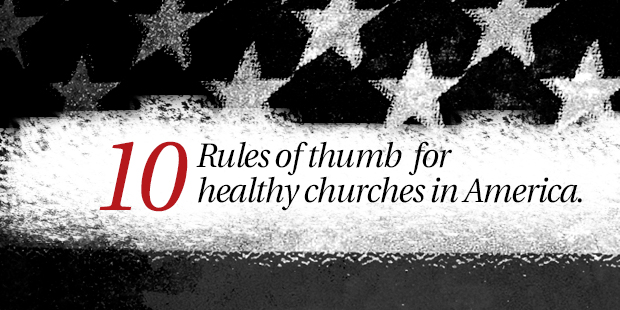
10 Rules of Thumb for Healthy Churches in America
Using rules of thumb to gauge church health is problematic because they are, well, rules of thumb. There will always be exceptions, extenuating circumstances, and even disagreements on the right metrics.
I thus realize I am taking a risk when I publish these broad guidelines. There is the greater risk that someone will take these numbers as infallible and perfectly suited for his or her congregation. Please let wisdom prevail. So many factors, such as demographics, multiple sites, and history will always provide better insights than mere numbers.
Nevertheless, I provide you these ten rules of thumb as a starting point. You can then wisely discern how well and specifically they apply to your situation.
- Number of acres needed for church site: one acre for every 125 in attendance. This ratio is based on useable acres. That number is affected by zoning requirements, water retention requirements, and property shape, to name a few.
- Parking Spaces: one space for every 2 people in attendance.
- Parking Area: 100 spaces for every acre used for parking.
- Evangelistic effectiveness: 12 conversions per year for every 100 in average attendance. Different congregations used different terminology: conversions, baptisms, professions of faith, salvations, etc. In this metric, the number refers to those in the past year who became Christians and became active in that specific congregation.
- Seating space per attendee: 27 inches. That number was 20 inches at one time. It has changed due to larger posteriors and greater cultural space desires.
- Maximum capacity of a facility: 80% full. This old tried and true ratio is still good. When a facility is 80% full architecturally, it feels 100% full.
- Retention effectiveness: For every 10 new members added per year, average worship attendance should increase by 7.
- Effective giving; For every person in average attendance, including children and preschool, $26.00 in budget receipts. For example, a church with an average worship attendance of 100 should average at least $2,600 in weekly budget giving. This ratio is obviously greatly impacted by demographics.
- Maximum debt payment budgeted: 33 percent of annual income for most churches. Up to 40 percent for fast-growing churches.
- Maximum debt owed: 2.5 times the annual income of the church for the previous year.
So how do you evaluate these rules of thumb? How is your church doing? What would you recommend I change or add?
Read more from Thom here.

Tags: Church Health, Thom Rainer, Vision Frame












